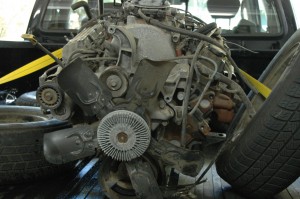Used Magnum engines are readily available, once you know where to look. 5.9 Magnum engines were production engines in Dodge and Jeep trucks, vans, and and SUVs from 1993–2003. The 5.2 Magnum was available in 1992. The 5.2 is more common but less desirable for our purposes due to its smaller displacement.
Craigslist and Ebay are good places to look for a swap engine. Car-Part.com has a user friendly search engine and lists available engines and other parts in scrap yards across the US, Mexico, and Canada. You can sort these results by distance and price, and we can usually find several good candidates within 200 miles. Buying from a scrapyard can be a little more expensive, but the engines usually carry a warranty. Not to mention, scrapyards generally have more information about an engine’s history than private sellers.

Fresh from the scrapyard, our 5.9 Magnum engine needs some prep before installation in our Dodge Dart.
Identification
All Magnum engines are stamped either 360 or 318 on the driver’s side near the rear of the block. The casting number found on all 360 Magnum blocks is 5302006, whereas the 5.2/318 Magnums are 53006714 or 53006657. Otherwise, the 5.2 and 5.9 appear pretty much identical. Make sure you verify whether it’s a 5.2 or 5.9 before you take possession. You don’t want any nasty surprises down the road!
How can I tell if it’s any good?
The unfortunate truth is, unless there is something obviously wrong with the engine, it is very difficult to tell the exact condition of the engine you are buying. With a used engine, there are literally a million things that can go wrong. Most sellers are not amenable to pulling the heads and such prior to selling. In our experience, we have found that well-maintained engines, even with high mileage, still run like new.
We suggest these tips when shopping for a used engine:
• Try to gauge whether the outward appearance of the engine matches the stated mileage. Magnums are not typically prone to oil leaks and are painted from the factory. If the engine is rusty and gunky, it is probably a high mileage engine.
• Check the oil for coolant.
• Check the remaining coolant for oil.
• If the engine does not have exhaust manifolds, use a flashlight to check the exhaust valves for carbon accumulation or other gunk.
• Check the dipstick. Often you can get an idea on whether the oil has been changed regularly by looking at the dipstick or peeking through the oil fill hole. If the seller is amenable, pull a valve cover. Heavy stains or gunk are signs that the engine went a long time between oil changes.
While it doesn’t matter if the truck is 2WD or 4WD, it is a good idea to source an engine that used the same transmission type you intend to use in your project. For example, if you intend to use a 727, 904, or other automatic, you should source an engine from an automatic donor vehicle. The Magnum has a unique external balance to other Mopar engines, so having the appropriate flexplate/flywheel can save a lot of hassle. Be sure to ask if the flexplate/flywheel comes with the engine, as not all sellers include them.
